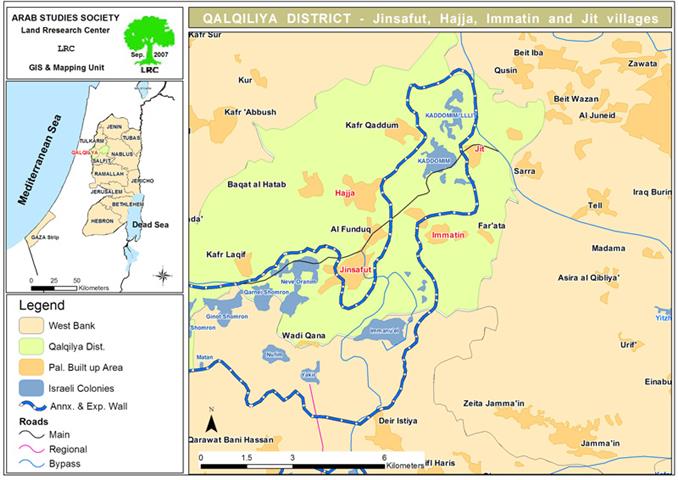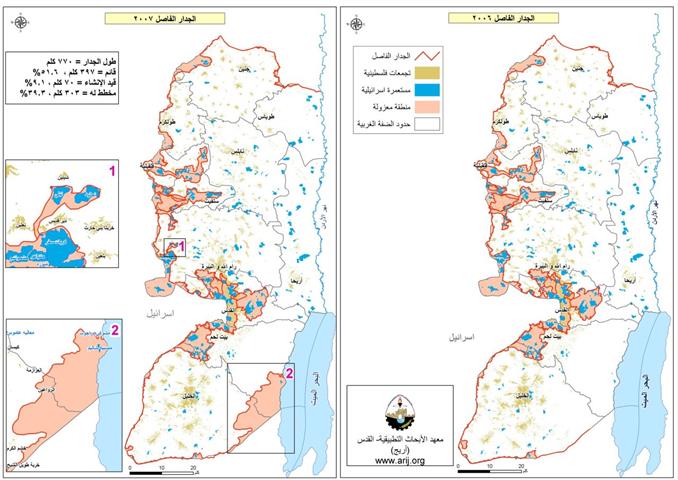The Israeli occupation authorities continue their campaign of demolition and demolition warning against houses and other structures in the Palestinian villages in the eastern part of Qalqiliay district, particularly, the villages of Jinsafut and Hajja under the pretext of un-licensing. See Map 1
For example, on July 12th, 2007, an agricultural farm belonging to Mrs. Safiya Basalat from Hajja village was demolished after it had been warned in June, 2006 under the pretext of building in zone C without licensing.
On the same day, a two floor house with a total surface area of 360 square meters owned by Mr. Abdul Fattah Rashid Ali Rashid, 51 years old, from Jinsafut was demolished under the same pretext.
(Photo1: Jinsafut- Qalqiliya: ruins of the house of Mr. Abdul Fattah Rashid)
Mr. Rashid is a simple farmer and has a family of 11 members. He spent most of his life earning money to get his family house built in the only piece of land he owns in the northern side of the village, which is part of the area designated as zone C by Oslo agreement ( under total Israeli security and civic affairs). He spent 45 000 ( forty five thousand US $) in building the house which was intended to be the dwelling place for the whole family, however, in September, 2005, he received a demolition warning from the Israeli occupation authorities who gave him un ultimatum until November, 2005, to submit all the required papers and documentation to Beit Eil military court. In response, Mr. Rashid presented the documentation on time, but, the court ruled that the house backward spaces ( regressions) are not in compliant with the Israeli standards, although the building is located in the occupied territories and should not be subject to Israeli laws and regulations.
In May, 2006, the house owner received a second demolition warning and he started to collect signatures from neighbors approving the repressions of the house in order to refute the Israeli allegations and objections regarding this point. When he took all the signatures to Beit Eil court along with his lawyer on 16.7.2006 they both were dismissed from the court and warned not to come back. Because of the Israeli war against Lebanon last summer the house demolition was postponed until this year, July 12th, 2007.
( Photos 2,3,4: Jinsafut- Qalqiliya: Mr. Abdul Fattah Rashid and some of his family members
stand at the ruins of their house)
Dozens of houses demolished
During the past two years, another 11 Palestinian houses and other structures were demolished in the Qalqiliay villages of Hajja, Al Funduq, Imatin and Jinsafut for the same pretext, some of which are located in the vicinity of Mr. Rashid's demolished house.
(Photo 5: Jinsafut- Qalqiliya: Ruins of another house that was demolished during the past period)
More demolition warnings
Since the beginning of last June 5 additional houses and animal farms were issued demolition warnings by the Israeli occupation authorities for being built in zone C. The following tables provides information about these structures:
|
No. |
Owner's name |
Type of structure |
Location |
|
1 |
Basam Abdul Jaber Basalat |
House |
Hajja |
|
2 |
Yusif Mohammed Sukar |
Animal farm |
Jinsafut |
|
3 |
Sami Zaki Basalat |
House & farm |
Hajja |
|
4 |
Majid Anis Basalat |
House |
Hajja |
Source: Field work by LRC
( Photo 6: Jinsafut- Qalqiliya: a copy of the Israeli issued demolition warning)
( Photos 7,8,9: Jinsafut- Qalqiliya: houses threatened with demolition in zone C)
It is worth mentioning that ever since the outbreak of the second uprising (Intifada) in the year 2000 the total of 30 houses and other structures have been issued demolition warnings. This policy is part of the psychological war being waged against owners who received demolition warnings as they live in constant fear and insecurity. In this regards, Mr. Mohammed Amin Eid, 49 years old, from Jinsafut who received a warning before 9 months said that his live has become a nightmare. He spent 160000 $ ( one hundred sixty thousand US $) to get his threatened house built. He added that 90 % of the houses in the above villages district are built in area C which put almost all the population under the risk of eviction.
Zone C: deducted at the expense of planning schemes
The Israeli occupation authorities preceded the Olso agreement in 1993 with the announcement of planning schemes for all the Palestinian cities, towns and villages in the West Bank in which it unilaterally drew up the borders of the built up areas for each Palestinian residential area based upon Israeli needs and greed. That is, all the Israeli – announced Palestinian built up schemes were confined to certain areas under the names of zone A and B and the remaining lands were announced as zone C which remained under total Israeli control security and civic control. The reason behind this policy was to name as much land as possible under zone C for the purpose of exclusive future Jewish use, that is, the expanding of the existing colonies and establishing new ones as in the case of Jinsafut which is surrounded by colonies like many other Palestinian towns and villages.
As a direct effect of this policy many villages and towns has lost most of their lands to zone C where Palestinians are not allowed to get any construction on these lands. The village of Jinsafut is a typical example. All of the threatened structures are located in zone C outside the borders of the Israeli imposed built up area of 1248 dunums (one dunum equals 1000 M2) out of 8658 dunums the total surface land area of Jinsafut.
The owners of the threatened houses were forced to build in zone C since they own no land within the Israeli announced planning scheme and they couldn't afford to buy, especially after the sharp increase on land prices because of the limited space for construction in compliance with the Israeli imposed scheme.
Location, Population and Area:
The village of Jinsafut, Qalqilia Governorate, is located 15 kilometers to the east of the city of Qalqilia. Its population is about 2,500 Palestinians. About 78% of the population used to depend on working in Israel and in the agricultural sector. Yet, due to the deteriorating security situation during the recent Intifadat Al Aqsa, a large percentage of the population became unemployed. The total area of the village is 8658 dunums of which 1248 is used for building purposes.
Related case studies
1. Jinsafut village's land devastated for Wall construction, Qalqilia Governorate, January, 2007
2. Warnings of demolitions in Jinsafut village, Qalqiliya governorate, February – 2007
Prepared by
The Land Research Center
LRC























